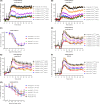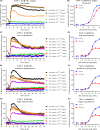Real-time examination of cAMP activity at relaxin family peptide receptors using a BRET-based biosensor
- PMID: 30263124
- PMCID: PMC6153321
- DOI: 10.1002/prp2.432
Real-time examination of cAMP activity at relaxin family peptide receptors using a BRET-based biosensor
Abstract
Relaxin family peptide (RXFPs) 1-4 receptors modulate the activity of cyclic adenosine monophosphate (cAMP) to produce a range of physiological functions. RXFP1 and RXFP2 increase cAMP via Gαs, whereas RXFP3 and RXFP4 inhibit cAMP via Gαi/o. RXFP1 also shows a delayed increase in cAMP downstream of Gαi3. In this study we have assessed whether the bioluminescence resonance energy transfer (BRET)-based biosensor CAMYEL (cAMP sensor using YFP-Epac-Rluc), which allows real-time measurement of cAMP activity in live cells, will aid in understanding ligand- and cell-specific RXFP signaling. CAMYEL detected concentration-dependent changes in cAMP activity at RXFP1-4 in recombinant cell lines, using a variety of ligands with potencies comparable to those seen in conventional cAMP assays. We used RXFP2 and RXFP3 antagonists to demonstrate that CAMYEL detects dynamic changes in cAMP by reversing cAMP activation or inhibition respectively, with real-time addition of antagonist after agonist stimulation. To demonstrate the utility of CAMYEL to detect cAMP activation in native cells expressing low levels of RXFP receptor, we cloned CAMYEL into a lentiviral vector and transduced THP-1 cells, which express low levels of RXFP1. THP-1 CAMYEL cells demonstrated robust cAMP activation in response to relaxin. However, the CAMYEL assay was unable to detect the Gαi3-mediated phase of RXFP1 cAMP activation in PTX-treated THP-1 cells or HEK293A cells with knockout of Gαs. Our data demonstrate that cytoplasmically-expressed CAMYEL efficiently detects real-time cAMP activation by Gαs or inhibition by Gαi/o but may not detect cAMP generated in specific intracellular compartments such as that generated by Gαi3 upon RXFP1 activation.
Keywords: CAMYEL; GPCR; RXFP; cAMP; relaxin; signalling.
Figures









Similar articles
-
Relaxin family peptide receptors RXFP1 and RXFP2 modulate cAMP signaling by distinct mechanisms.Mol Pharmacol. 2006 Jul;70(1):214-26. doi: 10.1124/mol.105.021691. Epub 2006 Mar 28. Mol Pharmacol. 2006. PMID: 16569707
-
Relaxin family peptide receptors--former orphans reunite with their parent ligands to activate multiple signalling pathways.Br J Pharmacol. 2007 Mar;150(6):677-91. doi: 10.1038/sj.bjp.0707140. Epub 2007 Feb 12. Br J Pharmacol. 2007. PMID: 17293890 Free PMC article. Review.
-
Prolonged RXFP1 and RXFP2 signaling can be explained by poor internalization and a lack of beta-arrestin recruitment.Am J Physiol Cell Physiol. 2009 May;296(5):C1058-66. doi: 10.1152/ajpcell.00581.2008. Epub 2009 Mar 11. Am J Physiol Cell Physiol. 2009. PMID: 19279230
-
Using the novel HiBiT tag to label cell surface relaxin receptors for BRET proximity analysis.Pharmacol Res Perspect. 2019 Jul 30;7(4):e00513. doi: 10.1002/prp2.513. eCollection 2019 Aug. Pharmacol Res Perspect. 2019. PMID: 31384473 Free PMC article.
-
Receptors for relaxin family peptides.Ann N Y Acad Sci. 2005 May;1041:61-76. doi: 10.1196/annals.1282.010. Ann N Y Acad Sci. 2005. PMID: 15956688 Review.
Cited by
-
Adenylyl cyclase isoforms 5 and 6 in the cardiovascular system: complex regulation and divergent roles.Front Pharmacol. 2024 Apr 3;15:1370506. doi: 10.3389/fphar.2024.1370506. eCollection 2024. Front Pharmacol. 2024. PMID: 38633617 Free PMC article. Review.
-
Opticool: Cutting-edge transgenic optical tools.PLoS Genet. 2024 Mar 22;20(3):e1011208. doi: 10.1371/journal.pgen.1011208. eCollection 2024 Mar. PLoS Genet. 2024. PMID: 38517915 Free PMC article. Review.
-
A synthetic BRET-based optogenetic device for pulsatile transgene expression enabling glucose homeostasis in mice.Nat Commun. 2021 Jan 27;12(1):615. doi: 10.1038/s41467-021-20913-1. Nat Commun. 2021. PMID: 33504786 Free PMC article.
-
A Real-Time, Plate-Based BRET Assay for Detection of cGMP in Primary Cells.Int J Mol Sci. 2022 Feb 8;23(3):1908. doi: 10.3390/ijms23031908. Int J Mol Sci. 2022. PMID: 35163827 Free PMC article.
-
Relaxin and extracellular matrix remodeling: Mechanisms and signaling pathways.Mol Cell Endocrinol. 2019 May 1;487:59-65. doi: 10.1016/j.mce.2019.01.015. Epub 2019 Jan 17. Mol Cell Endocrinol. 2019. PMID: 30660699 Free PMC article. Review.
References
-
- Bathgate RA, Kocan M, Scott DJ, et al. The relaxin receptor as a therapeutic target – perspectives from evolution and drug targeting. Pharmacol Ther. 2018;187:114‐132. - PubMed
-
- Bathgate RAD, Halls ML, van der Westhuizen ET, Callander GE, Kocan M, Summers RJ. Relaxin family peptides and their receptors. Physiol Rev. 2013;93:405‐480. - PubMed
-
- Bathgate RA, Ivell R, Sanborn BM, Sherwood OD, Summers RJ. International Union of Pharmacology LVII: recommendations for the nomenclature of receptors for relaxin family peptides. Pharmacol Rev. 2006;58:7‐31. - PubMed
Publication types
MeSH terms
Substances
LinkOut - more resources
Full Text Sources
Other Literature Sources
Molecular Biology Databases

